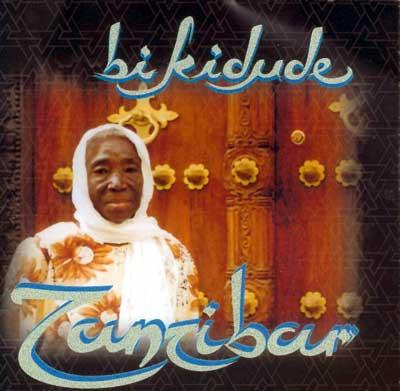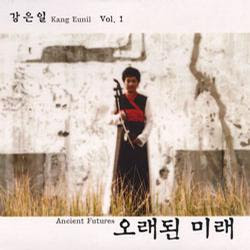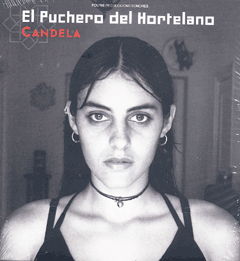-
Par DJDemonAngel le 17 Août 2010 à 16:00

http://en.wikipedia.org/wiki/Bi_Kidude
Origine du Groupe : Zanzibar
Style : World Music
Sortie : 1999<script type="text/javascript"> // <![CDATA[ aR_BgColor=""; aR_FgColor=""; aR_url=location.href; aR_title=document.title; aR_StarType ='3'; document.write('</div>'); document.write('<scr'+'ipt type="text/JavaScript" src="http://addratings.com/aR_BootStrap.js"></scr'+'ipt>'); // ]]> </script>La mémoire de Zanzibar
Connue en Europe pour sa participation au Culture Musical Club, Bi Fatuma Binti Baraka, dite Bi Kidudé, est la doyenne des chanteuses de Zanzibar. « Madame (bi) petite chose(Kidudé)» tient son surnom swahili de sa petite taille et sa réputation de son grand talent.
Si son âge reste flou, probablement autour de 90 ans, sa carrière a démarré dans les années 20 elle apprit son art auprès de la chanteuse Siti bint Saad. Pour échapper à un mariage forcé à 13 ans elles s’est un temps tenu éloignée de Zanzibar. Elle a vécut en Tanzanie et en Egypte où elle fut la chanteuse de plusieurs orchestre de danses. Toute sa vie, elle pratique deux styles très distincts, chantant au sein de taarab, ces grands orchestres festifs surgis à la fin du 19e siècle, après l’arrivée de musiciens égyptiens sur l’île de Zanzibar. Les orchestres de taraab comprennent des violons, un oud, un qanun, mais aussi des percussions venues d’Asie et des claviers occidentaux. Ils pratiquent une musique métissée qui incorpore des éléments de culture typiquement swahilis, arabes africaines et asiatiques. En qualité de chanteuse percussionniste et guérisseuse, Bi Kidudé participe depuis toujours aux rites d’initiations Unyago pour le passage des femmes à la puberté et "henna" pour l’initiation des futures épouses.
En 1999, lors du festival du film de Zanzibar, elle a reçu un award d’honneur pour sa vie passée au service de l’art. En novembre 2005 le Womex lui remet un award pour célèbrer sa carrière qui est sa première consécration au niveau international.
par Benjamin MiNiMuM
permalink
Tracklist :
1. Bomwanzani Wa Mahaba
[with Twinkling Stars] 10.02
2. Machozi Ya Huba
[with Twinkling Stars] 6.57
3. Unyago(A)
[with Unyago troupe] 6.30
4. Muhogo Wa Jang'ombe
[with Twinkling Stars] 4.36
5. Arebaba Pakistan
[with Twinkling Stars] 4.52
6. Unyago(B)
[with Twinkling Stars] 2.39
7. Arebaba Pakistan
[with Taarab All Stars] 6.32
8. Muhogo Wa Jang'ombe
[with Shikamoo Jazz & Twinkling Stars] 7.11
9. Beru
[with Shikamoo Jazz] 7.49
10. Kijiti
[with Shikamoo Jazz] 6.46 votre commentaire
votre commentaire
-
Par DJDemonAngel le 14 Août 2010 à 13:00

Note :





http://www.myspace.com/haegumplus
Origine du Groupe : South Corea
Style : World Music , Ambient , Instrumental , Classical
Sortie : 2003Kang Eun Il is one of the world's most acclaimed Haegum artists and is regarded as the forerunner of crossover music, combining traditional Korean music with non-traditional genres. Ancient Futures, her debut album, combines various musical genres: traditional, classical, jazz and improvisation (used for soundtrack of Kim Ki-Duk’s movie “Hwal” - "The Bow"). She has greatly broadened the scope of her instrument, playing with famous musicians and orchestras both at home and abroad. Kang has long been interested in the possibility of bringing her instrument to a wider audience by experimenting with crossover music and this has led to her collaborative work on popular songs with a number of famous jazz musicians. Really beautiful, emotional music !
by slow-riot
permalink
Tracklist :
1. 웽이자랑 Wongijarang (Cheju Lullaby)
2. 비상 Soaring
3. 초수대엽 Chosudaeyeop
4. 헤이 야 Hey Ya!
5. 오래된 미래 Ancient Futures
6. 비에 젖은 해금 A Wet Haegum With Rain
7. 라다끄의 여인 Ladakh’s Women
8. 낡은 마루 Old Floor
9. Fade Out votre commentaire
votre commentaire
-
Par DJDemonAngel le 13 Août 2010 à 14:00

Note :





http://www.elpucherodelhortelano.com
http://www.myspace.com/elpucherodelhortelanooficial
Origine du Groupe : Spain
Style : World Music , Gitan Music
Sortie : 2005Nace en 1998 formado por un grupo de amigos estudiantes de educación musical en la Universidad de Granada. Ese mismo año graban una maqueta de seis temas con la intención de dejar constancia de tantas y noches de fiesta y música, para que quedara un recuerdo de esos años, y para sorpresa se venden 3500 copias, y además les lleva a ser premiados en varios concursos andaluces, entre los que destaca el Lagarto Rock de Jaén.
Ese el punto de partida para que decidan lanzarse al mundo del bussines musical, y grabando su primer y segundo disco, “Aficiones” (2000) y “Once temas de conversación” (2002) para la compañía granadina Producciones Peligrosas. Estos dos años dan para mas de 200 conciertos por todo el país, dos nominaciones a los premios de la música de Andalucía,(mejor canción y mejor álbum de flamenco fusión por Aficiones),la inclusión de un par de temas en la música de la película de Alberto Rodríguez “Siete Vírgenes” nominada a los premios Goya 2006, y más de 10.000 copias vendidas de unos discos que apenas tienen promoción y distribución, lo que les sitúa como una de las bandas más auténticas y originales del país.
Durante el siguiente año centran más su actividad en Cataluña, donde se trasladan algunos miembros de la banda, y donde conocen a Carles Lloveras, un guitarrista flamenco catalán que se incorpora a la banda y por medio del cual conocen a la compañía discográfica que les grabará su tercer disco.
Es en el 2005 cuando graban “Candela” para la discográfica catalana “Fourni produccions sonores”, distribuido por K-industria, un disco grabado en la Casa de la Fournier, en la Garriga (Barcelona) y mezclado en Granada, en el que sorprenden con una formación recién estrenada más acústica y callejera,( se incorpora el chelo a la banda y se prescinden de las guitarras eléctricas de anteriores discos), y que recibe las mejores críticas de los medios: Candela es una modélica obra de flamenco rock urbano, donde se desenvuelven el puridad el tanguillo, la copla y la bulería, aunque para el oído común se oye transitar a Kiko Veneno, al Chico Ocaña más sentimental, al lenguaje pop también, todo hermosamente dicho (inmenso Antonio Arco) e interpretado. La versión de “Jel’aime a mourir” de Francis Cabrel es para enmarcar.- La Vanguardia - por Esteban Linés. (26 de Agosto 2006).
En el 2006 el primer single de Candela, “Quiero Saber” es incluido en el recopilatorio “Carácter Flamenco” editado por Discmedi, junto a artistas como Martires del compás. Miguel Poveda, Duquende, Ojos de Brujo... Al finalizar 2006 Candela lleva vendidas más de 5000 copias y 250.000 canciones descargadas de su pagina web oficial www.elpucherodelhortelano.com
Transcurridos dos años desde el lanzamiento de “Candela” el puchero nos presenta ahora su cuarto disco “HARUMAKI” ., que estará en la calle el 3 de diciembre de 2007.
HARUMAKI son once nuevas composiciones que parten de inteligentes letras y buenas melodías y que se visten con el flamenco, la rumba, el pop, el rock, el funky,…En este nuevo disco te encontrarás guitarras flamencas que a veces suenan gitanas y a veces se saturan y distorsionan, arreglos clásicos de cuerda, vibrantes y alevosos vientos, una contundente base rítmica a cargo del cajón del “faraón”, y por supuesto un hilo conductor, la voz rota de Antonio Arco, curtida en nueve años de trayectoria. Una voz que ya ha creado un estilo propio e inconfundible.
HARUMAKI se ha grabado en los estudios granadinos de Producciones Peligrosas por Pablo Sánchez (Enrique Morente, Los Planetas, Estrella Morente, etc), y se ha mezclado por Carlos Díaz (Eskorzo, Lagartija Nick, Amparanoia, etc) durante la primavera y verano de 2007. Es un disco que aparece bajo el propio sello del propio grupo, Aficiones Records y la distribución en España corre a cargo de la compañía catalana “Discmedi”.
Como novedad señalar que tras la marcha del guitarrista Carles Lloveras en 2006, se incorpora a la banda y graba este disco la joven guitarrista flamenca de Barbate (Cádiz), Patricia Ramos.
En breve comienzan una gira que les llevará de nuevo a todos los rincones para dar a todo el que guste Harumaki del bueno.
RadioChango
permalink
Tracklist :
01. Pablito
02. Miedo
03. Si te Miro
04. Ochenta Años
05. Vive la Vida
06. Arrancarme los Ojos
07. Quiero Saber
08. De Todas las Cosas
09. Bulerías del Poli Díaz
10. Puchero de Caramelos
11. La Quiero a Morir votre commentaire
votre commentaire
-
Par DJDemonAngel le 13 Août 2010 à 12:00
 Note :
Note : 




http://www.myspace.com/susheela.raman
Origine du Groupe : U.K , India
Style : World Music
Sortie : 2007
Attention cette jeune femme pése son pesant d'or si je puis dire !
Susheela Raman anglaise d'origine indienne nous a offert un dernier album toujours aussi magiquement mystique . Toujours accompagner par ce fabuleux guitariste Sam Mills compagnon dans la vie et sur scène de cette diva a la voix envoutante .
Le nouvel album " 33 1/3 " de Susheela expérimente des reprises de groupes et artistes bien connu tel que : Jimmy Hendrix avec un voodoo chile magnifique ou encore les Rolling Stones .
Bref Susheela ne dénature pas ces musiques et leur redonne un esprit encore plus vivace grace à cette force mystérieuse qui la fait vibrer .
Je vous conseille plus que vivement d'aller voir cette artiste en concert qui à coup sûr vous ravira , j'ai tester et j'ai approuvé !
Merci Susheela that's very great music .
by DJ DemonAngel
Tracklist :
1 · I'm Set Free
2 · Yoo Doo Right
3 · Where Did You Sleep Last Night
4 · Like a Rolling Stone
5 · Love Lies
6 · Oh My Love
7 · Voodoo Chile
8 · Heart and Soul
9 · Persuasion
10 · Ruler of My Heart votre commentaire
votre commentaire
-
Par DJDemonAngel le 10 Août 2010 à 16:00

Note :





http://www.nonesuch.com/albums/the-bahamas-the-real-bahamas-in-music-and-song
Origine du Groupe : V.A Bahamas
Style : World Music
Sortie : 2003 (1965)Most of the major Bahama Islands lie no further than 200 miles off the Florida coast. The United States has had generally a greater influence on the history and development of this British colony than did the Spanish-speaking Caribbean islands to its south and east. This is also true for most of the music of the Bahamas; certainly it is true in the case of the music presented in this album—the religious vocal music of “rhyming spirituals” and anthems.
The songs and the style heard here are the result of alternate periods of contact with and isolation from the United States mainland. The Bahama colony was established at about the same time as the Carolina colony: around 1670. Africans from many tribes—Ibos, Ijos, Yorubas, Mandingoes, Ashantis—were imported as slaves to both places, as well as to other British settlements in the New World. Whereas tribal identity quickly vanished in the mainland colonies, one’s awareness of a particular African heritage remained intact to a great extent in many of the European-colonized islands. This was so in the Bahamas, where the surrounding waters provided temporary insulation against outside influences; there is still an awareness of tribal distinction in some parts of the Bahamas. During the Revolution in the mainland colonies, a group of Loyalists left the Carolinas with their many slaves and settled on Abaco Cays in the Bahamas, where a number of freed slaves also had come to live. A vital new music had been developing in the Carolinas, as well as throughout the whole of the Southern plantation area. This music was now brought to the Bahamas, where a similar development may have been taking place. Here, the very old songs were preserved (and are in fact still sung), and a distinctly Bahamian style of singing developed simultaneously with the further development of the American Negro spiritual.
Emancipation came to the Bahamas in 1838; escaped slaves from the southern American states sought refuge in the free islands, particularly Andros, largest of the Bahamas. Until the end of the Civil War, there was a steady inflow of African-Americans to Andros and, with them, their songs. Isolation and poverty insured the preservation of these songs, so that Bahamian music today reflects many of the developments in mainland music that occurred over a very long period. We can hear in the older music of the Bahamas something that may be close to the very early plantation slave music.
The “rhyming spiritual” is the distinctive Bahamian type of religious song. “Rhyming” simply means intoning couplets against a melodic background of voices. (“Rhyme” here means “verse”—not necessarily coinciding final syllables.) The rhymer—the lead singer—sings a memorized or improvised rhythmic narrative part that continues to build in intensity while the other singers repeat a chorus behind him—that is, they sing the song. The rhyming style reached its greatest heights during the sponge fishing in the 1930s.
A West African tradition of singing sermons has been carried on, and further developed, in the New World. We can hear it in church services conducted by preachers who bring their congregations to heights of religious fervor by the gradual transition during the sermon from speech to song—song of tremendous intensity and power. Rhyming seems to be the combination of the traditions of singing sermons and African drum and bell rhythms. The rhythmic patterns in rhyming are also found in West African music. While there is still some drumming in the Bahamas, it had been forbidden in the mainland colonies and had to go underground. The intricate handclapping that developed in the Carolina and Georgia Sea Islands may be a compensation for lost bells and drums. In the Bahamas, where there is little handclapping, the singing sermon became the means for utilizing this and other rhythms. Other features of African music, such as the call-and-response vocal pattern, also found their way into Bahamian song.
JODY STECHER, 1966
permalink
Tracklist :
01. We Will Understand It Better By and By 3:54
02. Sheep Know When Thy Shepherd Calling 2:08
03. I Told You People Judgment Coming 0:53
04. Don’t Take Everybody to Be Your Friend 2:18
05. Sailboat Malarkey 2:18
06. Up in the Heaven Shouting 1:33
07. Won’t That Be a Happy Time 2:24
08. Out on the Rolling Sea 3:12
09. I Am So Glad 1:40
10. Come for Your Dinner 1:28
11. God Locked the Lion’s Jaw 4:01
12. Great Dream from Heaven 2:39
13. My Lord Help Me to Pray 1:42
14. Numberless As the Sands on the Seashore 4:15
15. I Ain’t Got Long 1:21
16. I Bid You Goodnight 2:48 votre commentaire
votre commentaire Suivre le flux RSS des articles de cette rubrique
Suivre le flux RSS des articles de cette rubrique Suivre le flux RSS des commentaires de cette rubrique
Suivre le flux RSS des commentaires de cette rubrique










